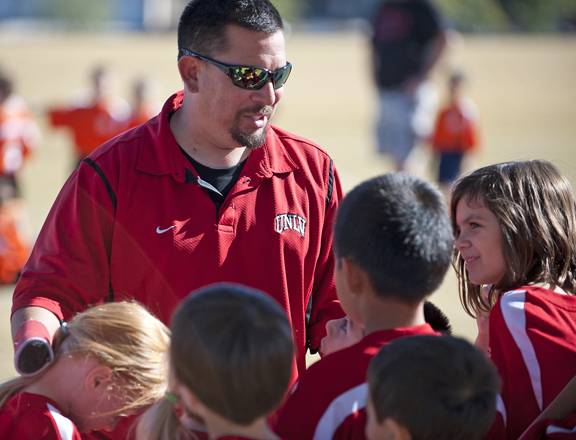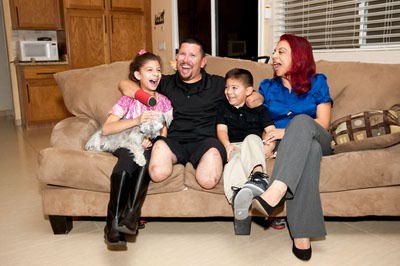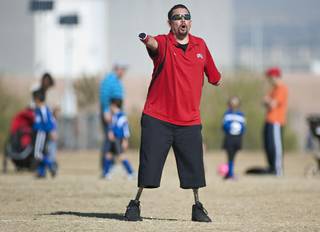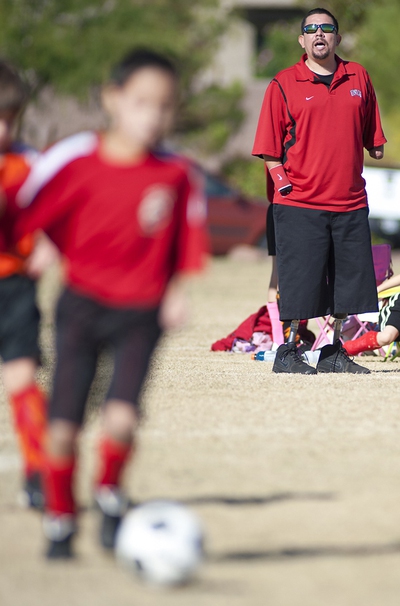
Stephen Sylvanie
Youth soccer coach Eddie Garcia gathers his players together for a small pep talk before starting the second half of the team’s final game of the season on Saturday morning at Reunion Trails Park.
Friday, Nov. 22, 2013 | 2 a.m.
The ice cream truck’s melody carries across the soccer fields at Heritage Park in Henderson. The driver smartly parks near the youth fields while kids begin dragging their parents over, hoping for a postgame treat before heading home.
Eddie Garcia is on a field coaching in the final game of the season. By the time the truck’s music wafts over the game, Garcia’s Under-11 girls team is leading 5-0, though he’s trying to convince his players the score is still 0-0.
The Garcias are veterans in the Henderson Recreation scene. This is the second game today for the whole family — Eddie, his wife, Antoinette, son Ryan, 7, and daughter Haley, 11. Garcia is used to the drill; he’s been coaching here since 2007.
The family started the day at Reunion Trails Park, where Garcia coached Ryan's Under-8 game and before piling everything into their 2005 white Ford Expedition for Round Two.
Garcia, 38, is wearing a red UNLV polo T-shirt and dark sunglasses below his short, buzzed hair. On the sidelines Garcia stands at 5-foot-9, an inch taller than he measured last January. Back then he was known to be relentlessly positive.
That hasn’t changed much, despite vastly different circumstances.
This weekend in San Diego, Garcia will receive the Youth Coach of the Year Award from the National Alliance of Youth Sports. He’s been coaching in some capacity for the past 20 years, but the honor really reflects how far he’s come in the past 10 months.
That journey dominates most of his conversations these days. But what’s important right now is his interaction with a young player who’s explaining that she was a little slow because she rolled her ankle on the field.
“I have that problem, too,” he says while mimicking the move, “my foot goes this way and that way.”
The girl pauses. She doesn’t quite get the joke.
“But you have no foot,” she responds.
Garcia is standing on two prosthetic legs that give him the extra inch he didn't have before. His arms end with nubs where his wrists used to be. He smiles.
“Oh, yeah.”
• • •
Garcia had spent seven years at Morris Behavior School when the job offer came before the 2012-13 school year to be the dean at Canyon Springs High. This would be a challenge; Canyon Springs was much bigger and tougher than Morris.
On Jan. 14, while supervising lunch at Canyon Springs, Garcia started to feel ill. Antoinette had been sick with strep throat the previous week and Garcia figured he caught it.
He needed to go home and rest, and not expose any kids at school.
Before he left the building Garcia stopped by his office, leaned back in his chair and took a moment to put his feet up on his desk. Had he known then what was coming, Garcia would have stood on those feet to run around the halls or used his hands to touch and grip everything in sight.
But he didn’t know what he was about to endure. Garcia had never heard of necrotizing fasciitis, more commonly known as the flesh-eating bacteria, and he had no knowledge of the physical consequences of surviving it. So instead of kissing his hands Garcia went home and passed out.
He wouldn’t remember much about the next couple of months.
• • •
Eddie Garcia grew up in Pico Rivera, Calif. His father died when he was 9, leaving his mother, a native of Mexico, to raise him and an older brother in a neighborhood tagged by competing gangs.
His mom didn’t know a lot about the school system but she knew enough to keep her kids away from the streets. A lot of different sets in the area would wear Nike Cortez shoes to display their affiliation, and the one time Garcia brought home a pair his mother quickly tossed them out.
“She ripped the shoes off and nearly took the feet with them,” Garcia said.
Garcia and Antoinette met in the first grade. The marriage came later but the bond that has kept them relentlessly positive through what most outsiders would view as a tragedy started back then.
“I’d probably be in a depressed state if not for my wife,” Garcia said. “She has taken this challenge, our life challenge, and turned it around.”
• • •
The Garcia family usually sleeps in the same bed but Antoinette took the kids upstairs to let Eddie sleep off his illness downstairs. She didn’t think much more about it until Eddie texted the next day saying he needed to go to urgent care.
When Antoinette, a counselor at Basic High, got home and stepped in the front door the stench was unmistakable yet hard to pinpoint. It wasn’t vomit or something tangible, still, it reminded her of a hospital. She knew something was wrong.
“You could smell sickness,” she said.
Garcia was so out of sorts he demanded Antoinette wash his sweats before they left so he’d be more presentable at the urgent care center in Henderson. Doctors knew Garcia was fighting a bacteria but they weren’t sure yet precisely what they were up against.
The Garcias' lives were built around routines and systems, so the next day Antoinette went to work as normal. Only when a friend pointed out that she was at school while her husband was in urgent care did she recognize the absurdity and leave to go by his side.
A couple of friends came to visit that night and Garcia could barely maintain a conversation. Once one of the most energetic and happy people they knew, he now was withering away and they didn’t know why.
When Antoinette finally went home that night she texted Garcia a photo of her and their kids in bed. He sent back "I love you."
About an hour and a half later the hospital called. It was three days after Garcia had gone home early thinking he had a sore throat.
“They said, ‘You need to round up the family,’” Antoinette said. “‘We don’t expect your husband to make it through the night.’”
• • •
Life at Cal State Fullerton wasn’t easy for Garcia, especially early on as he struggled with poor grades. The world at CSF was bigger than anything he had experienced before then, and it took time to adjust. It was another challenge he had to take on.
After graduating as a double major in communications and administration he took a public relations internship at a Fox affiliate in his area. When that ended he found himself at a crossroads familiar to millions of graduates with a pile of debt and only a vague idea what they want to do.
Garcia needed a job, so he picked up the Whittier Daily News and scanned the classifieds. In high school he was too small or too slow to excel at sports so he drifted toward coaching. He was a basketball manager and helped coach volleyball.
Coaching has a lot in common with teaching, probably more than Garcia ever expected. Lesson plans and game plans aren’t too different; learning is always paramount in both positions.
Garcia saw an ad for a teaching position and called. A man told Garcia he was sorry but they had just filled the position. Garcia thanked him and nearly hung up when the man’s voice changed.
“Eddie, is that you?”
The man was one of Garcia’s old recreation-league softball teammates. He sent Garcia to St. Gregory the Great Parish School in Whittier, just a few miles from where Garcia grew up, to interview for a sixth-grade teaching position. With his friend’s recommendation Garcia was hired on the spot. He figured he would teach for a year, maybe two, and then return to public relations.
“That class changed my course,” Garcia said. “I ended up becoming a teacher because of them.”
• • •
After the hospital’s call, Antoinette left the kids with her father and took her mother to the hospital, where Antoinette started making calls to their closest family and friends.
"You need to come," she told them. "Eddie’s not going to make it."
Garcia’s internal organs were failing and doctors decided to put him into a coma. Their best guess was he would never wake up and put his life expectancy at no better than 20 percent.
Once he made it through the first night, Antoinette and the doctors noticed that a rash on Garcia's right thigh had grown. They prepped him for surgery, giving Antoinette hope because at least there was something to be done. The surgeon searched through the muscle tissue and fat to find the bacteria causing Garcia's illness layered deep inside his leg.
Test results took about 72 hours. Through every one of those, Antoinette and close family friends lived in limbo, not knowing if Eddie would stay alive long enough for them to even find out what he had.
“We hoped for the absolute best and there was really nothing else we could do,” said Monique Arroyo, who grew up with Garcia and then watched her daughter play on one of his teams locally. “It was out of our hands.”
Results came back with the diagnosis doctors most feared: necrotizing fasciitis. It can spread rapidly and they performed multiple surgeries on the leg trying to clean it all out.
For the first two weeks Antoinette lived with the understanding that Garcia could die at any time. Doctors put Garcia on four blood-pressure medications. They redirected blood from his extremities to his core to help his failing organs.
This strategy can work for a little while but if employed too long, limbs may never recover.
That’s what happened.
Without regular circulation, Garcia’s hands and feet became hard and black; closer to petrified wood than flesh and bone.
It was a trade Antoinette would have made 100 percent of the time: Garcia's life for his limbs.
There wasn’t a guarantee it would work but after many up-and-down days the outlook looked brighter in February. Antoinette was in the room when they pulled Eddie out of his coma. He didn’t recognize her or understand much about the situation. Garcia only had one thing on his mind as he tried to get out of bed.
“I gotta coach. I gotta coach,” Garcia said. “What day is it, is it Saturday? I gotta coach.”
• • •
Back in 2004, tragedy brought the Garcias to Las Vegas. After their daughter Haley was born, the Garcias suffered a few miscarriages while living in southern California. They needed a fresh start and Garcia heard about affordable homes in Las Vegas.
In order to close on a house they would end up losing in the recession, Garcia showed up for an interview with the Clark County School District on a Monday morning and got the job, including proof of employment for the home loan, later that day.
They had thought about renting out the Las Vegas property and still living primarily in California but Antoinette fell in love with the area. So did her parents, who moved to the Valley shortly after.
Over time they all made a happy home here. Garcia organized, played with and coached a softball team with some of his fellow teachers and administrators at Morris, and at home he tried to teach Antoinette how to cook without burning herself.
They lived their own American dream.
• • •
In the ensuing weeks of Garcia's recovery, he started to recognize friends and return to his jovial demeanor. Garcia would bang his useless hand against the desk to lighten the mood. He tried to make his hospital visitors feel better when they left than when they entered.
All kinds of people came to see him -- students from Canyon Springs and Morris, players and families from his youth teams and even people from California he hadn’t seen in years. Garcia doesn’t have to wonder what his wake would be like because he saw it in those rooms.
“The fight within me came from the people visiting and supporting me,” Garcia said.
On Feb. 21, doctors amputated Garcia's legs. About a month later they took his right hand at the wrist and then his left hand at mid-forearm. In between the amputations he celebrated his 38th birthday.
Doctors didn't know how Eddie he caught the disease. Here’s the family’s best guess:
The strain of virus can come from a strep infection, like the one Antoinette believes she had the week before Eddie went to urgent care. While taking care of her, Garcia suffered a cut on his finger, possibly giving the bacteria the open wound it needed to have an impact.
The National Centers for Disease Control estimates that there are about 650-800 cases of necrotizing fasciitis caused by strep in the U.S. each year. It’s a very rare disease, particularly in healthy people.
Garcia had pulled a muscle in his right leg shortly before he started showing symptoms. The bacteria often attacks a weakened area, usually somewhere the patient had recently had surgery.
That’s only a theory. The Garcias will never know for certain.
Antoinette’s father, Eddie Lopez, also caught the bacteria. The family thinks Garcia handed him something and it became infectious when Lopez scratched a small cut on his head.
His face started to swell and the family forced him to get it checked out immediately. Because Garcia had been diagnosed by then, doctors didn’t have to guess what it was and began treating him for necrotizing fasciitis immediately. He was out in a few days.
Garcia's stay lasted three months and three weeks over three main stops. After that first visit to urgent care, he checked into St. Rose Dominican Hospitals — Rose de Lima Campus, then moved to University Medical Center for the bulk of his recovery before finishing at HealthSouth Rehabilitation.
There wasn’t much for Garcia to do at rehab. Generally, recovering patients can build up their arms are legs. Garcia had only his core. Instead, he found the help he needed in sports.
“My rehab is coaching,” Garcia said.
• • •

Eddie Garcia, whose positive attitude is remarkable, laughs with his his wife, Antoinette, daughter, Haley, 11, and son Ryan, 7 while posing for a family portrait in their Henderson home Wednesday evening, Nov. 11, 2013. Eddie lost his arms and legs due to complication from a skin-eating bacterial infection in January 2013.
Garcia keeps a walker on the sidelines for when his legs inevitably get tired. After a day spent standing in his prosthetic legs he usually needs another day or more to recover.
Phantom pain keeps him up at night. Speaking to a group of athletes recently at Desert Pines High, Garcia raises his left arm and tells the kids he’s waving. He can feel it even if they can’t see it.
Garcia is constantly shaking his limbs the same way someone else would to regain feeling after a foot falls asleep. He doesn’t know if that feeling will ever go away, or if he’ll start sleeping normally again. I’m new at this, he says, and he’s hopeful things will continue to progress despite the occasional doubt that creeps in.
“I hope this is not the way I’m going to have to continue living my life,” Eddie says.
So far the major breakthrough in making use of his right stump is the use of a wristband. He can wedge a fork, comb or stylus pen to use with his phone in between his arm and the wristband to gain control of many daily activities.
Still, there’s so much he relies on his family to help him with. While he was in the hospital the Garcias, including Antoinette’s parents, all moved under the same one-story roof. Garcia gets around the house in a motorized chair and getting ready to leave often takes well over an hour.
“Everything’s a production,” Antoinette says.
They’re looking into a home health care worker, one of many things they knew nothing about before any of this happened. Add to that list all the guidelines for a charitable foundation, which they recently established.
There have been a few fundraisers for the family and that money is sitting in a couple of accounts. Some of that will go to trying to modify things in the house, like the bathroom, to make daily life easier. Some of it will go to a scholarship through their Be Strong and Win Foundation.
They’re giving $1,253.17 — the amount Garcia received in a surprise financial aid check that he credits to helping him stick it out in college — annually to a college-bound senior in CCSD, starting this year. They’ve asked students to write an essay about an obstacle they’ve overcome.
“We want to help the little Eddies in the world, people who didn’t have it easy but are pulling through,” Garcia says.
Those same type of kids are the ones Garcia says he identifies with as a coach. And despite his different appearance they identify with him, too.
Garcia desperately wanted to coach this fall to give himself something to look forward to and reasons to get out of the house. At the first practice with his U-8 team he sat down all the parents and coaches to explain what had happened and took questions. By the second week, no one had any more questions.
“It’s just the way he is and the way he carries himself that it’s not an impediment," said assistant coach and parent Alex Fugazzi.
The kids, including his own, see Garcia mostly the same way he sees himself. The limbs are gone and the person remains, as optimistic about the future as ever.
Garcia doesn’t know what the future will bring. Part of him wants to return to a school environment, or at least work with kids in some capacity, but he’s a long way from being able to handle a full-time job. Garcia had enough sick days built up over the years that he only recently had to apply for long-term disability.
Garcia believes he has a second chance for a reason. He has plenty of ideas what he’s supposed to do with it and in time he’s certain he’ll figure it out. Garcia’s not simply content to be alive for the same reason he doesn’t want his teams content with a 5-0 lead.
Taylor Bern can be reached at 948-7844 or [email protected]. Follow Taylor on Twitter at twitter.com/taylorbern.



Join the Discussion:
Check this out for a full explanation of our conversion to the LiveFyre commenting system and instructions on how to sign up for an account.
Full comments policy